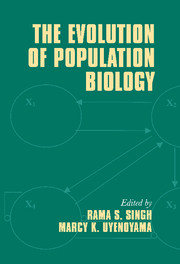Book contents
- Frontmatter
- Contents
- List of contributors
- Publications of R. C. Lewontin
- Preface
- Introduction
- Part I Historical foundations and perspectives
- Part II Genotypes to phenotypes: new genetic and bioinformatic advances
- 3 Genetic dissection of quantitative traits
- 4 Gene expression profiling in evolutionary genetics
- 5 Population biology and bioinformatics
- 6 Beyond beanbag genetics: Wright's adaptive landscape, gene interaction networks, and the evolution of new genetic systems
- Part III Phenotypes to fitness: genetics and ecology of populations
- Part IV Genes, organisms, and environment: evolutionary case studies
- Part V Applied population biology: biodiversity and food, disease, and health
- Index
5 - Population biology and bioinformatics
Published online by Cambridge University Press: 08 January 2010
- Frontmatter
- Contents
- List of contributors
- Publications of R. C. Lewontin
- Preface
- Introduction
- Part I Historical foundations and perspectives
- Part II Genotypes to phenotypes: new genetic and bioinformatic advances
- 3 Genetic dissection of quantitative traits
- 4 Gene expression profiling in evolutionary genetics
- 5 Population biology and bioinformatics
- 6 Beyond beanbag genetics: Wright's adaptive landscape, gene interaction networks, and the evolution of new genetic systems
- Part III Phenotypes to fitness: genetics and ecology of populations
- Part IV Genes, organisms, and environment: evolutionary case studies
- Part V Applied population biology: biodiversity and food, disease, and health
- Index
Summary
Introduction
There have been two major technological breakthroughs in the last 20 years. One has been in the power, speed and cost of computers and the second has been in the basic knowledge, sequencing abilities and technologies of molecular biology. Both areas are rapidly leading to major new innovations and are changing our daily lives. Many of the changes are unforeseen and many affect our lives in ways that were not anticipated and may not even be recognized as having anything to do with these advances.
To give but one such example of events that are shaping our lives I need only consider what happens every time that I go to the grocery store. At the check-out line, the clerk will ask me for my AIRMILES card and will “swipe” it through a scanner after ringing in my purchases. When I go to the department store, I will be asked if I subscribe to AIRMILES and if so, to supply the card so that they may record my purchases. Anytime that I go to the local hardware store, to the drugstore, to the shoe store to the garden supply store, … it seems, when I go to most any store they ask me for my AIRMILES card.
- Type
- Chapter
- Information
- The Evolution of Population Biology , pp. 94 - 103Publisher: Cambridge University PressPrint publication year: 2004



